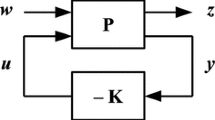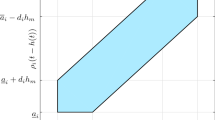Abstract
The so-called digital redesign (DR) is a sampled-data (SD) controller design method where an analogue controller is designed firstly, and then transformed to an approximately equivalent digital controller in the sense of state-matching. In this approach, the SD controller is designed by reducing the discrepancy between the discrete-time (DT) counterpart of the closed-loop SD control system and the continuous-time (CT) closed-loop system. In this paper, we develop a DR strategy for CT linear time-invariant systems. More specifically, H ∞ norm of the error dynamic system between the CT and DT plants is minimized for the optimal state-matching performance at every sampling point. The design problem is formulated as linear matrix inequalities which can be efficiently solved by using convex optimization techniques. Finally, an example is given to illustrate the effectiveness of the proposed method.
Similar content being viewed by others
References
D. S. Laila, Design and Analysis of Nonlinear Sampled-data Control Systems, Ph.D. dissertation, University of Melbourne, 2003.
T. Chen and B. A. Francis, Optimal Sampled-Data Control Systems, Springer-Verlag, London, U.K., 1995.
B. Bamieh, J. Pearson, B. Francis, and A. Tannenbaum, “A lifting technique for linear periodic systems,” Syst. Contr. Letts., vol. 17, no. 2, pp. 79–88, 1991.
Y. Yamamoto, “New approach to sampled-data control systems-a function space method,” Proc. 29th IEEE Conf. Decision Control, Honolulu, Hawaii, USA, 1990, pp. 1882–1887.
T. Hu, Y. Cao, and H. Shao, “Constrained robust sampled-data control of nonlinear uncertain systems,” Int. J. of Robust and Nonlinear Contr., vol. 12, no. 5, pp. 447–464, 2002.
T. Hu, J. Lam, Y. Cao, and H. Shao, “A LMI approach to robust H 2 sampled-data control for linear uncertain systems,” IEEE Trans. Syst., Man Cybern., vol. 33, no. 1, pp. 149–155, 2003.
D. H. Lee and Y. H. Joo, “Extended robust H2 and H ∞ filter design for discrete time-invariant linear systems with polytopic uncertainty,” Circuits Syst. Signal Process, vol. 33, no. 2, pp. 393–419, 2014.
S. Lall and G. Dullerud, “An LMI solution to the robust synthesis problem for multi-rate sampleddata systems,” Automatica, vol. 37, no. 12, pp. 1909–1922, 2001.
D. H. Lee, Y. H. Joo, and M. H. Tak, “Local stability analysis of continuous-time Takagi-Sugeno fuzzy systems: a fuzzy Lyapunov function approach,” Information Sciences, vol. 257, pp. 163–175, 2014.
E. Fridman, “A refined input delay approach to sampled-data control,” Automatica, vol. 46, no. 2, pp. 421–427, 2010.
P. Naghshtabrizi, J. P. Hespanha, and A. R. Teel, “Exponential stability of impulsive systems with application to uncertain sampled-data systems,” Syst. Contr. Letts., vol. 57, no. 5, pp. 378–385, 2008.
B. C. Kuo, Digital Control Systems, Rinehart, Winston, and Holt, New York, 1980.
J. Xu, G. Chen, and L. S. Shieh, “Digital redesign for controlling chaotic Chua’s circuit,” IEEE Trans. Aero. Electr., vol. 32, pp. 1488–1500, 1996.
L. S. Shieh, W. M. Wang, and M. K. A. Panicker, “Design of PAM and PWM digital controllers for cascaded analog systems,” ISA Trans., vol. 37, no. 3, pp. 201–213, 1998.
L. S. Shieh, W. M. Wang, J. Bain, and J. W. Sunkel, “Design of lifted dual-rate digital controllers for X-38 vehicle,” J. Guid., Control Dyna., vol. 23, pp. 629–639, 2000.
S. M. Guo, W. Wang, and L. S. Shieh, “Discretization of two degree-of freedom controller and system with state, input and output delays,” IEE Proc. Control Theory Applicat., vol. 147, no. 1, pp. 87–96, 2000.
S. M. Guo, L. S. Shieh, G. Chen, and C. F. Lin, “Effective chaotic orbit tracker: a prediction-based digital redesign approach,” IEEE Trans. Circuits Syst. I, vol. 47, pp. 1557–1570, 2000.
Y. H. Joo, G. Chen, and L. S. Shieh, “Hybrid state space fuzzy model-based controller with dual-rate sampling for digital control of chaotic systems,” IEEE Trans. Fuzzy Syst., vol. 7, no. 4, pp. 394–408, 1999.
W. Chang, J. B. Park, H. J. Lee, and Y. H. Joo, “LMI approach to digital redesign of linear timeinvariant systems,” IEE Proc. Control Theory Applicat., vol. 149, no. 4, pp. 297–302, 2002.
W. Chang, J. B. Park, Y. H. Joo, and G. Chen, “Design of sampled-data fuzzy-model-based control systems by using intelligent digital redesign,” IEEE Trans. Circuits Syst. I, vol. 49, no. 4, pp. 509–517, 2002.
H. J. Lee, H. B. Kim, and Y. H. Joo, “A new intelligent digital redesign for T–S fuzzy systems: Global approach,” IEEE Trans. Fuzzy Syst., vol. 12, no. 2, pp. 274–284, 2004.
H. J. Lee, J. B. Park, and Y. H. Joo, “Digitalizing a fuzzy observer-based output-feedback control: intelligent digital redesign approach,” IEEE Trans. Fuzzy Syst., vol. 13, no. 5, pp. 701–716, 2005.
H. J. Lee, J. B. Park, and Y. H. Joo, “Further refinement on LMI-based digital redesign: deltaoperator approach,” IEEE Trans. Circuits Syst. II, vol. 53, no. 6, pp. 473–477, 2006.
D. W. Kim, J. B. Park, and Y. H. Joo, “Effective digital implementation of fuzzy control systems based on approximate discrete-time models,” Automatica, vol. 43, no. 10, pp. 1671–1683, 2007.
G. B. Goo, J. B. Park, and Y. H. Joo, “Intelligent digital redesign for nonlinear systems using a guaranteed cost control method,” International Journal of Control, Automation, and Systems, vol. 11, no. 6, pp. 1075–1083, 2013.
H. C. Sung, J. B. Park, and Y. H. Joo, “Robust control of observer-based sampled data systems: digital redesign approach,” IET Control Theory Appl., vol. 6, no. 12, pp. 1842–850, 2012.
D. W. Kim, J. B. Park, and Y. H. Joo, “Theoretical justification of approximate norm minimization method for intelligent digital redesign,” Automatica, vol. 44, no. 3, pp. 851–856, 2008.
D. W. Kim, J. B. Park, and Y. H. Joo, “Robust stabilization of sampled-data control systems with nonlinear perturbations via digital redesign,” IET Control Theory Appl., vol. 3, no. 8, pp. 1070–1080, 2009.
D. H. Lee and Y. H. Joo, “Linear matrix inequality approach to local stability analysis of discrete-time Takagi-Sugeno fuzzy systems,” IET Control Theory Appl., vol. 7, no. 9, pp. 1309–1318, 2013.
H. C. Sung, J. B. Park, and Y. H. Joo, “Observerbased sampled-data control for nonlinear systems: robust intelligent digital redesign approach,” International Journal of Control, Automation, and Systems, vol. 12, no. 4, pp. 486–496, 2014.
H. C. Sung, J. B. Park, Y. H. Joo, and K. C. Lin, “Robust digital implementation of fuzzy control for uncertain systems and its application to active magnetic bearing system,” International Journal of Control, Automation, and Systems, vol. 10, no. 3, pp. 603–612, 2012.
S. Boyd, L. EI Ghaoui, E. Feron, and V. Balakrishnan, Linear Matrix Inequalities in Systems and Control Theory, SIAM, Philadelphia, PA, 1994.
M. C. de Oliveira, J. C. Geromel, and J. Bernussou, “Extended H 2 and H ∞ norm characterizations and controller parametrizations for discrete-time systems,” Int. J. Control, vol. 75, no. 9, pp. 666–679, 2002.
C. E. de Souza and L. Xie, “On the discrete-time bounded real lemma with application in the characterization of static feedback H ∞ controller,” Syst. Contr. Letts., vol. 18, no. 1, pp. 61–71, 1992.
M. Green and D. J. N. Limebeer, Linear Robust Control, Prentice-Hall, Englewood Cliffs, NJ, 1995.
P. Gahinet, A. Nemirovski, A. J. Laub, and M. Chilali, LMI Control Toolbox, MathWorks, Natick, MA, 1995.
J. F. Sturm, “Using SeDuMi 1.02, a MATLAB toolbox for optimization over symmetric cons,” Optim. Meth. Software, vol. 11–12, pp. 625–653, 1999.
J. Löfberg, “YALMIP: a toolbox for modeling and optimization in MATLAB,” Proc. IEEE CCA/ISIC/ CACSD Multiconf., pp. 284–289, http://control.ee.ethz.ch/joloef/yalmip.php, 2004.
M. C. de Oliveira, J. Bernussou, and J. C. Geromel, “A new discrete-time robust stability condition,” Syst. Contr. Letts., vol. 37, no. 4, pp. 261–265, 1999.
C. T. Chen, Linear System Theory and Design, Holt, Rinehart and Winston, 1984.
N. Rafee, T. Chen, and O. P. Malik, “A technique for optimal digital redesign of analog controllers,” IEEE Trans. Aero. Electr., vol. 5, no. 1, pp. 89–99, 1997.
G. B. Koo, J. B. Park, and Y. H. Joo, “Intelligent digital redesign for nonlinear systems using a guaranteed cost control method,” International Journal of Control, Automation, and Systems, vol. 11, no. 6, pp. 1075–1083, 2013.
D. H. Lee, M. H. Tak, and Y. H. Joo, “A Lyapunov functional approach to robust stability analysis of continuous-time uncertain linear systems in polytopic domains,” International Journal of Control, Automation, and Systems, vol. 11, no. 3, pp. 460–469, 2013.
D. H. Lee, Y. H. Joo, and M. H. Tak, “Periodically time-varying H ∞ memory filter design for discretetime LTI systems with polytopic uncertainty,” IEEE Trans. Automat. Control, vol. 59, no. 5, 2014.
Author information
Authors and Affiliations
Corresponding author
Additional information
Dong Hwan Lee received his B.S. degree in Electronic Engineering from Konkuk University, Seoul, Korea, in 2008 and his M.S. degree in Electrical and Electronic Engineering, Yonsei University, Seoul, Korea, in 2010. From 2014, he is working toward a Ph.D. degree at the Department of Electrical and Computer Engineering, Purdue University, USA. He was the recipient of the Outstanding Paper Award in Graduate School of Yonsei University Thesis Award Fall 2010 and the recipient of the Student Paper Award in ICCAS 2010. He is an Associate Editor of IEEE Transactions on Fuzzy Systems. His current research interests include stability analysis in fuzzy systems, fuzzy-model-based control, and robust control of uncertain linear systems.
Young Hoon Joo received his B.S., M.S., and Ph.D. degrees in Electrical Engineering from Yonsei University, Seoul, Korea, in 1982, 1984, and 1995, respectively. He worked with Samsung Electronics Company, Seoul, Korea, from 1986 to 1995, as a project manager. He was with the University of Houston, Houston, TX, from 1998 to 1999, as a visiting professor in the Department of Electrical and Computer Engineering. He is currently a professor in the Department of Control and Robotics Engineering, Kunsan National University, Korea. His major interest is mainly in the field of intelligent robot, intelligent control, robot vision, human-robot interaction, wind farm control, and intelligent surveillance systems. He severed as President for Korea Institute of Intelligent Systems (KIIS) (2008–2009) and as the Vice-President for the Korean Institute of Electrical Engineers (KIEE) (2013–2014) and is serving as Editor-in-Chief for the Intelligent Journal of Control, Automation, and Systems (IJCAS) (2014-present).
Sung Kwan Kim received his B.S. and M.S. degrees from the School of Electronics and Information Engineering at Kunsan National University, Korea, in 2013 and 2015, respectively. He is currently working toward a Ph.D. degree at the Department of Control and Robotics Engineering from Kunsan National University, Korea. His research interests include intelligent surveillance system, robot vision, and human-robot interaction.
Rights and permissions
About this article
Cite this article
Lee, D.H., Joo, Y.H. & Kim, S.K. H ∞ digital redesign for LTI systems. Int. J. Control Autom. Syst. 13, 603–610 (2015). https://doi.org/10.1007/s12555-014-0326-7
Received:
Accepted:
Published:
Issue Date:
DOI: https://doi.org/10.1007/s12555-014-0326-7




